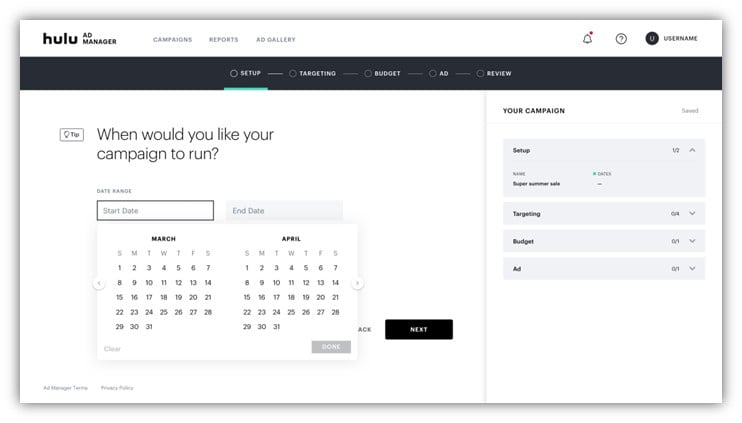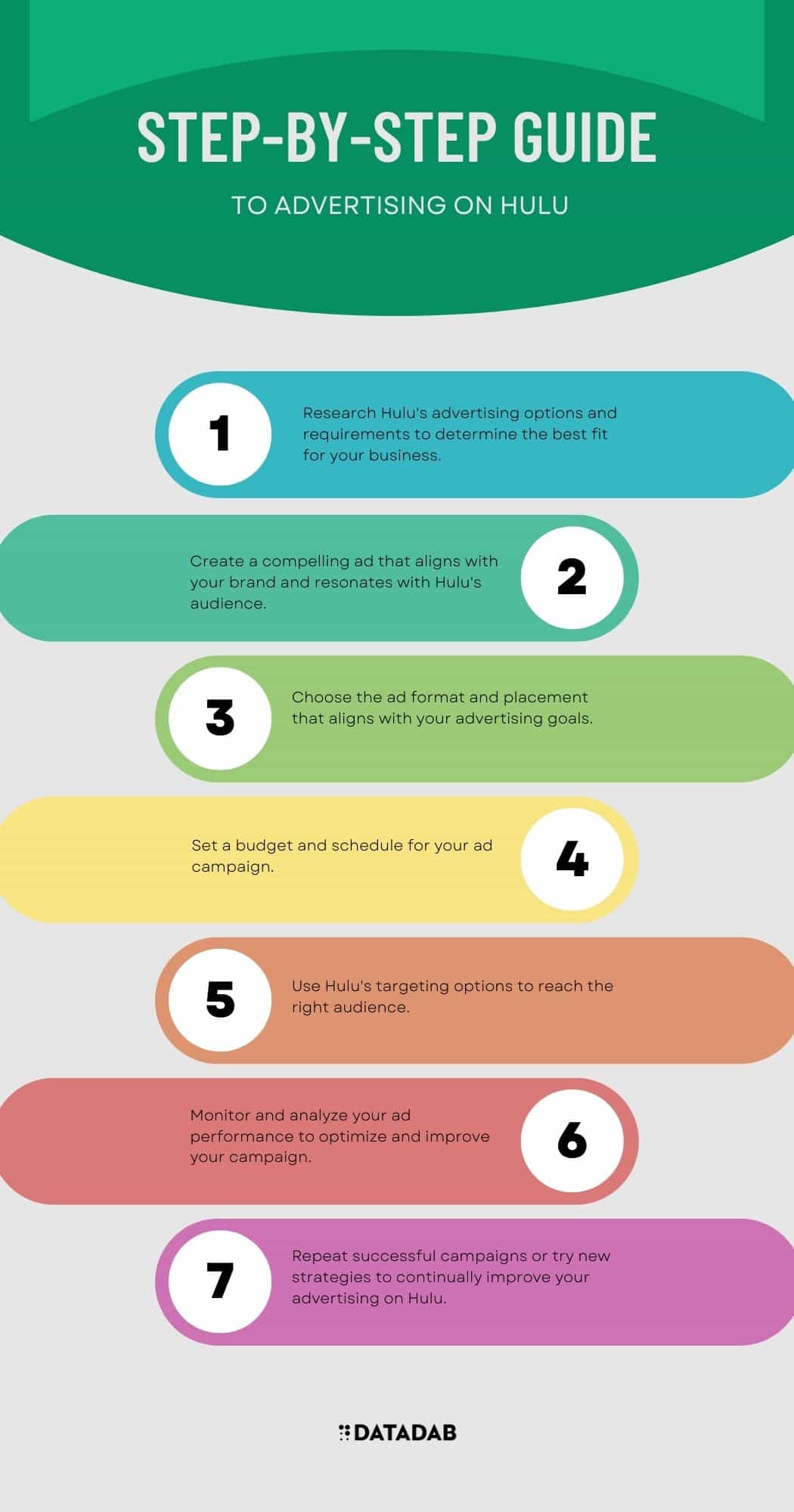My clients are always asking me where they should spend their precious advertising dollars. It's my job to research the latest platforms and provide data-driven recommendations tailored to their unique audiences and goals. Lately, many clients have been curious if streaming services like Hulu are worth exploring as an advertising channel.
I'll admit, I was skeptical at first. B2B brands don't usually align with the entertainment-focused content on Hulu. But the more I researched, the more potential I saw. Did you know over 82 million viewers tune into Hulu every month? And the average viewer is only 32 years old, making it the ideal place to reach coveted millennial decision-makers.
Plus, Hulu lets you drill down into targeted audience segments in a way not possible on traditional television. You can specify the exact shows, channels, times of day, devices, and even viewer interests you want your ads to reach. As a data-driven marketer, getting this precise with targeting gets me excited.

The bottom line is that while Hulu may seem unexpected for B2B brands, I believe it's shaping up to be a smart and measurable advertising play for the right campaign goals and audiences. In fact, I'm planning dedicated Hulu campaigns for several clients over the next quarter to test it out. I predict it will only continue growing as a strategic platform for savvy marketers.
What is Hulu?
Hulu is one of the big three streaming services in North America. It is available on Roku, Amazon Fire TV, gaming consoles, smart TVs, mobile devices, and more. There’s no need for an additional cable box or satellite dish—all you need is an internet connection to watch Hulu on your computer or through a streaming device.
Viewers can watch Hulu in two ways: the free version (with ads) and the paid subscription “Hulu With No Ads” plan. The free version has commercials that appear during breaks in episodes being streamed. Hulu has a huge number of subscribers using both versions of their service.

How effective is advertising on Hulu?
Hulu is the second-largest ad-supported video-on-demand service in the US, with over 25 million subscribers. Hulu makes money primarily through advertising, so they’ve had to get creative to keep users watching and attract new viewers.
First and foremost, this means that you will have more options for targeting your audience because Hulu has less stress about subscriptions than Netflix does about ads.
They also have a younger demographic—the average user is only 32 years old—so if your key market happens to be under 40, then advertising on Hulu is a great place to start. Plus, their combined reach of over 76% between television and online viewership puts them ahead of their competitors in sheer numbers.
How much does it cost to advertise on Hulu?
It's true, this kind of advertising isn't cheap. The cost of a campaign on Hulu depends on the type of ad you want to run (like an interactive overlay or a full-screen ad that takes over the whole screen) and how specific you want to target your viewers. Most of Hulu's ads are purchased via CPM, which means advertisers pay based on how many impressions their ad gets.
You can expect to spend between $10-$20 per thousand views for most types of ads on Hulu. This is comparable to cable TV rates and cheaper than many other digital video platforms.
For example, if you're planning a national awareness campaign lasting only one week, it would cost about $80K for 375M impressions.

How do ads work on Hulu?
The first thing to understand is that Hulu is the only streaming service with ads. This is because Hulu is licensed by TV networks, while Netflix and Amazon Video are not.
Hulu's ad-supported model allows you to watch as many shows and movies as you want, as many times as you want, at no cost! The way it works is that every time you watch something, you get a little bit of advertising before it. This means that Hulu will play an ad for one of its sponsors most of the time.
If you don't want to see ads on Hulu, you can pay $12.99 per month for the no-ad version of Hulu with limited commercials available. This allows you to see all the content on Hulu without any interruptions or distractions from ads.
An ad on Hulu works in a couple of ways.
First, every hour a commercial will play, and it can either be a regular ad that any company could buy or a Hulu original commercial. Hulu makes those commercials and they are designed to fit into the existing content the company provides. They are made by the same people who make their shows and are placed accordingly (if an episode is about fast food restaurants, there is an ad for one at the right time).
Second, when you're searching for something on Hulu you're given results that are paid ads. The ads themselves are frequently live-streams of things like cooking videos or trailers of movies. You also get results that aren't ads that you can choose to watch if you'd like.

Can I target specific viewers on Hulu?
- Audience targeting
Hulu’s audience targeting allows you to reach your desired target segment by age, gender, location, and interests. Each of these dimensions will come up when creating your campaign. If you want to narrow down your audience, you can choose specific shows and channels to target. In addition, if there are any particular audiences that you’d like to exclude from seeing your ad, you can do so here as well.
- Retargeting campaigns
You can also set up a retargeting campaign that targets viewers who have already watched one of your videos or visited a website in the past 30 days with personalized ads on Hulu. This is a great way to continue engaging consumers after they’ve interacted with content related to your brand or product.
- Device targeting
Device targeting lets you choose which Hulu-supported device types (iPhone, iPad, Android, or desktop web) you’d like to run ads on. With this option, the ad runs only on the devices selected—so if mobile is important in reaching your desired audience or driving action (like app downloads), be sure it’s included as part of the mix!
- Daypart targeting
Daypart targeting lets advertisers define what time of day their ads will run using standard dayparts: morning/daytime/early fringe/late fringe/primetime/late night/overnight.
What types of ads can I run on Hulu?
The most common type of ad on Hulu is what we call pre-rolls. These ads run before the video starts, typically 15 or 30 seconds. Because these ads aren’t interrupting the viewer mid-show, they’re usually not skippable, but often have an interactive element (like a button to “Learn More”).
If you have a longer video (1 minute or more), you can also use mid-rolls. Mid-roll ads play at various points during the video and are generally between 30 and 90 seconds long. Skipping depends on whether it’s close to the end of a given episode of content or if it’s less than 60 seconds into the show.
Lastly, there are post-rolls that play after the content has finished airing — these can be 15 or 30 seconds and are not skippable by default.
Does my ad need specific video requirements for Hulu advertising?
Does my ad need specific video requirements for Hulu advertising? Yes. Hulu has strict requirements about your videos' format, length, and size. We recommend using an expert to create these ads, so you're confident they'll meet the guidelines.
Here are the specifics:
- Format: .mp4
- Length: Under 30 seconds
- Size: 300MB or less
- Resolution: At least 720p (1280 x 720)
It's also important that your video have subtitles for this channel and a clickable URL link.
Is my campaign eligible for advertising on Hulu?
When you start to advertise on Hulu, it's good to know whether or not your campaign will be eligible. The types of ads that are not allowed include:
• Gambling content
• Tobacco products and smoking accessories
• Ads for political campaigns and candidates running for office
• Alcoholic beverages; beer, wine, liquor, hard cider, etc.
• The types of campaigns that are eligible for advertising on Hulu include:
• Drugs and pharmaceutical products (including over-the-counter drugs)
• Entertainment services such as movie theaters, theme parks, and concert venues
Can I target specific shows and channels with advertising on Hulu?
Hulu ad campaigns target audiences in two different ways:
- Content-based targeting: Hulu allows you to target a specific show, channel, or content genre. This is particularly useful for brands that want to advertise on user-generated content such as music vids or fan channels.
- Audience-based targeting: Hulu allows you to target audience segments by demographic and psychographic data, including age, gender, income level, and viewing history. This is most commonly used by advertisers who want to reach a more general audience. For example, the video below shows how an advertiser can combine audience-based targeting with content-based targeting to create a targeted reach campaign on Hulu.
More FAQs
1. What types of ads can be run on Hulu?
Hulu offers three main types of video ads:
- Pre-roll ads: These 15 or 30-second video ads play before your selected video begins. They are not skippable since they play before the content starts. Pre-rolls often have interactive elements like a "Learn More" button.
- Mid-roll ads: These ads play at various intervals during the video, typically 30 to 90 seconds in length. Mid-roll ads may be skippable depending on the video length and time placement.
- Post-roll ads: 15 or 30-second ads that play after the video ends. Post-rolls are not skippable by default.
2. What options exist for targeting specific groups of Hulu viewers?
Hulu offers robust targeting capabilities to reach your desired audience segments:
- Demographic targeting: Target by age, gender, location down to the zip code.
- Content targeting: Choose specific shows, networks, genres to target viewers of that content.
- Audience targeting: Target groups with specific interests and viewing behaviors.
- Device targeting: Serve ads exclusively on iPhone, Android, tablet, or desktop viewers.
- Retargeting: Reach viewers who have previously watched your videos or visited your website with customized ads.
- Daypart targeting: Define which dayparts (morning, afternoon, primetime etc) to advertise in.
3. What requirements exist for the video ads run on Hulu?
Hulu has strict video ad requirements including:
- File format must be .mp4
- Length under 30 seconds
- File size less than 300 MB
- Minimum 720p resolution (1280 x 720 pixels)
- Must have subtitles and clickable call-to-action
4. What is the average cost to advertise on Hulu?
- Most Hulu ads are purchased on a CPM (cost per thousand impressions) basis:
- Average CPM rates range from $10-$20
- Sample national campaign costs:
- 1 week campaign: ~$80,000
- 375 million impressions
5. Can I run gambling, tobacco, alcohol or political ads on Hulu?
No. Hulu prohibits ads in categories like gambling, tobacco, alcohol, guns, and political/issue campaigns. Advertisers cannot promote these types of products, services or messages on the platform.
6. Can I track the performance of my Hulu ad campaigns?
Yes. Hulu offers robust campaign performance tracking and analytics including:
- Impressions and reach metrics
- Video completion rates
- Click through rates
- Interaction rates for interactive overlays
- Brand lift and purchase intent surveys
This allows you to optimize your ads and determine the impact on brand awareness and favorability.
7. How does Hulu make money since much of the content is free?
Hulu generates revenue primarily through the sale of video advertising played before and during its content. This ad-supported model allows users to watch unlimited content for free in exchange for airing a limited number of ads. Hulu also generates revenue through its ad-free premium subscription plan.
8. Who owns and operates Hulu?
Hulu is a joint venture owned by The Walt Disney Company, 21st Century Fox, Comcast and Time Warner. While each company maintains ownership, Hulu operates independently out of its own management and workforce based in California.
9. How many subscribers does Hulu have currently?
As of early 2023, Hulu maintains over 25 million total subscribers. This includes both subscription plans as well as viewers using the free, ad-supported plan. Over 76% of Hulu's users are between the ages of 18-49 - a valuable demographic.
10. Why advertise on Hulu versus other platforms?
Great question. Here are the key advantages to Hulu:
- Massive viewing audience - 25 million+ engaged subscribers
- Viewer targeting capabilities - target precise audiences
- Younger, valuable viewer demographics - average age is only 32
- Ad-supported model - viewers used to seeing ads
- High completion and interaction rates - engaged viewers
- Brand lift surveys - quantify impact of campaigns
The combined reach, targeting options, and impact measurement capabilities make Hulu a uniquely positioned platform for video advertising campaigns.
Hulu's advertising options are hard to beat. Unlike some other platforms where your content may be drowned out by the company in question, Hulu's advertising matches the quality of their existing platform. They target viewers when they're at an optimal point of interest, and they aren't overbearing. This is a win-win situation for brands on both sides—viewers get quality content, and advertisers get exposure without being too intrusive.






